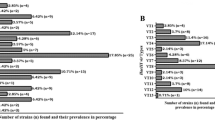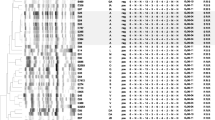Abstract
The profiling of the superantigen (SAg) encoding genes has been frequently used as a complementary typing method for group A streptococci (GAS), but a confusing gene nomenclature and a large diversity of primers used in screening has led to some conflicting results. The aim of this work was to develop a polymerase chain reaction (PCR) method capable of efficiently amplifying all the known allelic variants of these genes, and to evaluate the congruence of this methodology with other commonly used molecular typing methods. The presence of the 11 known SAg genes and two other exotoxin-encoding genes (speB and speF) was tested in a collection of 480 clinical GAS isolates, using two multiplex PCR reactions. The SAg gene profile was compared with other typing methods. Four naturally occurring deletions involving the genes speB, speF, and rgg were characterized, two of which were found among invasive isolates. The absence of the chromosomally encoded genes speG and smeZ was supported by Southern blot hybridization and associated with specific GAS lineages, while the presence of phage-encoded genes was more variable. Positive associations between SAg genes or between SAg profiles and emm types or pulsed-field gel electrophoresis (PFGE) clusters were observed. The results suggest that the SAg profile diversifies faster than other properties commonly used for molecular typing, such as emm type and multilocus sequence typing (MLST) sequence types (STs), and can be a useful complement in GAS molecular epidemiology. Still, the short-term stability of the SAg gene profile among prevalent genetic lineages may largely explain the observed associations between SAg genes.



Similar content being viewed by others
References
Cunningham MW (2000) Pathogenesis of group A streptococcal infections. Clin Microbiol Rev 13:470–511
Kotb M (1995) Bacterial pyrogenic exotoxins as superantigens. Clin Microbiol Rev 8:411–426
Sriskandan S, Faulkner L, Hopkins P (2007) Streptococcus pyogenes: Insight into the function of the streptococcal superantigens. Int J Biochem Cell Biol 39:12–19. doi:10.1016/j.biocel.2006.08.009
Gerlach D, Schmidt KH, Fleischer B (2001) Basic streptococcal superantigens (SPEX/SMEZ or SPEC) are responsible for the mitogenic activity of the so-called mitogenic factor (MF). FEMS Immunol Med Microbiol 30:209–216
Kapur V, Topouzis S, Majesky MW, Li LL, Hamrick MR, Hamill RJ, Patti JM, Musser JM (1993) A conserved Streptococcus pyogenes extracellular cysteine protease cleaves human fibronectin and degrades vitronectin. Microb Pathog 15:327–346. doi:10.1006/mpat.1993.1083
Bessen DE, Izzo MW, Fiorentino TR, Caringal RM, Hollingshead SK, Beall B (1999) Genetic linkage of exotoxin alleles and emm gene markers for tissue tropism in group A streptococci. J Infect Dis 179:627–636. doi:10.1086/314631
Beall B, Facklam R, Thompson T (1996) Sequencing emm-specific PCR products for routine and accurate typing of group A streptococci. J Clin Microbiol 34:953–958
Carriço JA, Silva-Costa C, Melo-Cristino J, Pinto FR, de Lencastre H, Almeida JS, Ramirez M (2006) Illustration of a common framework for relating multiple typing methods by application to macrolide-resistant Streptococcus pyogenes. J Clin Microbiol 44:2524–2532. doi:10.1128/JCM.02536-05
Lintges M, van der Linden M, Hilgers R-D, Arlt S, Al-Lahham A, Reinert RR, Plücken S, Rink L (2010) Superantigen genes are more important than the emm type for the invasiveness of group A Streptococcus infection. J Infect Dis 202:20–28. doi:10.1086/653082
Maripuu L, Eriksson A, Norgren M (2008) Superantigen gene profile diversity among clinical group A streptococcal isolates. FEMS Immunol Med Microbiol 54:236–244. doi:10.1111/j.1574-695X.2008.00469.x
Meisal R, Andreasson IKG, Høiby EA, Aaberge IS, Michaelsen TE, Caugant DA (2010) Streptococcus pyogenes isolates causing severe infections in Norway in 2006 to 2007: emm types, multilocus sequence types, and superantigen profiles. J Clin Microbiol 48:842–851. doi:10.1128/JCM.01312-09
Beres SB, Sylva GL, Barbian KD, Lei B, Hoff JS, Mammarella ND, Liu M-Y, Smoot JC, Porcella SF, Parkins LD, Campbell DS, Smith TM, McCormick JK, Leung DYM, Schlievert PM, Musser JM (2002) Genome sequence of a serotype M3 strain of group A Streptococcus: phage-encoded toxins, the high-virulence phenotype, and clone emergence. Proc Natl Acad Sci USA 99:10078–10083. doi:10.1073/pnas.152298499
McMillan DJ, Geffers R, Buer J, Vlaminckx BJM, Sriprakash KS, Chhatwal GS (2007) Variations in the distribution of genes encoding virulence and extracellular proteins in group A Streptococcus are largely restricted to 11 genomic loci. Microbes Infect 9:259–270. doi:10.1016/j.micinf.2006.11.014
Vlaminckx BJM, Schuren FHJ, Montijn RC, Caspers MPM, Beitsma MM, Wannet WJB, Schouls LM, Verhoef J, Jansen WTM (2007) Dynamics in prophage content of invasive and noninvasive M1 and M28 Streptococcus pyogenes isolates in The Netherlands from 1959 to 1996. Infect Immun 75:3673–3679. doi:10.1128/IAI.01695-06
Ikebe T, Wada A, Inagaki Y, Sugama K, Suzuki R, Tanaka D, Tamaru A, Fujinaga Y, Abe Y, Shimizu Y, Watanabe H; Working Group for Group A Streptococcus in Japan (2002) Dissemination of the phage-associated novel superantigen gene speL in recent invasive and noninvasive Streptococcus pyogenes M3/T3 isolates in Japan. Infect Immun 70:3227–3233
Smoot LM, McCormick JK, Smoot JC, Hoe NP, Strickland I, Cole RL, Barbian KD, Earhart CA, Ohlendorf DH, Veasy LG, Hill HR, Leung DYM, Schlievert PM, Musser JM (2002) Characterization of two novel pyrogenic toxin superantigens made by an acute rheumatic fever clone of Streptococcus pyogenes associated with multiple disease outbreaks. Infect Immun 70:7095–7104
Proft T, Webb PD, Handley V, Fraser JD (2003) Two novel superantigens found in both group A and group C Streptococcus. Infect Immun 71:1361–1369
Friães A, Ramirez M, Melo-Cristino J; Portuguese Group for the Study of Streptococcal Infections (2007) Nonoutbreak surveillance of group A streptococci causing invasive disease in Portugal identified internationally disseminated clones among members of a genetically heterogeneous population. J Clin Microbiol 45:2044–2047. doi:10.1128/JCM.00496-07
Silva-Costa C, Pinto FR, Ramirez M, Melo-Cristino J; Portuguese Surveillance Group for the Study of Respiratory Pathogens (2008) Decrease in macrolide resistance and clonal instability among Streptococcus pyogenes in Portugal. Clin Microbiol Infect 14:1152–1159. doi:10.1111/j.1469-0691.2008.02104.x
Silva-Costa C, Ramirez M, Melo-Cristino J (2006) Identification of macrolide-resistant clones of Streptococcus pyogenes in Portugal. Clin Microbiol Infect 12:513–518. doi:10.1111/j.1469-0691.2006.01408.x
Commons R, Rogers S, Gooding T, Danchin M, Carapetis J, Robins-Browne R, Curtis N (2008) Superantigen genes in group A streptococcal isolates and their relationship with emm types. J Med Microbiol 57:1238–1246. doi:10.1099/jmm.0.2008/001156-0
Rivera A, Rebollo M, Miró E, Mateo M, Navarro F, Gurguí M, Mirelis B, Coll P (2006) Superantigen gene profile, emm type and antibiotic resistance genes among group A streptococcal isolates from Barcelona, Spain. J Med Microbiol 55:1115–1123. doi:10.1099/jmm.0.46481-0
Schmitz F-J, Beyer A, Charpentier E, Normark BH, Schade M, Fluit AC, Hafner D, Novak R (2003) Toxin-gene profile heterogeneity among endemic invasive European group A streptococcal isolates. J Infect Dis 188:1578–1586. doi:10.1086/379230
Vlaminckx BJM, Mascini EM, Schellekens J, Schouls LM, Paauw A, Fluit AC, Novak R, Verhoef J, Schmitz FJ (2003) Site-specific manifestations of invasive group A streptococcal disease: type distribution and corresponding patterns of virulence determinants. J Clin Microbiol 41:4941–4949
Ausubel FM, Brent R, Kingston RE, Moore DD, Seidman JG, Smith JA, Struhl K (eds) (1999) Current protocols in molecular biology. Greene Publishing and Wiley Interscience, New York
Pinto FR, Melo-Cristino J, Ramirez M (2008) A confidence interval for the Wallace coefficient of concordance and its application to microbial typing methods. PLoS One 3:e3696. doi:10.1371/journal.pone.0003696
Severiano A, Pinto FR, Ramirez M, Carriço JA (2011) Adjusted Wallace coefficient as a measure of congruence between typing methods. J Clin Microbiol 49:3997–4000. doi:10.1128/JCM.00624-11
Jaccard P (1908) Nouvelles recherches sur la distribution florale. Bull Soc Vaud Sci Nat 44:223–270
Altman DG (1990) Practical Statistics for Medical Research. Chapman and Hall/CRC Press, Boca Raton
Benjamini Y, Hochberg Y (1995) Controlling the false discovery rate: a practical and powerful approach to multiple testing. J R Stat Soc Ser B Methodol 57:289–300
Darenberg J, Luca-Harari B, Jasir A, Sandgren A, Pettersson H, Schalén C, Norgren M, Romanus V, Norrby-Teglund A, Normark BH (2007) Molecular and clinical characteristics of invasive group A streptococcal infection in Sweden. Clin Infect Dis 45:450–458. doi:10.1086/519936
Ashbaugh CD, Wessels MR (2001) Absence of a cysteine protease effect on bacterial virulence in two murine models of human invasive group A streptococcal infection. Infect Immun 69:6683–6688. doi:10.1128/IAI.69.11.6683-6686.2001
Hollands A, Aziz RK, Kansal R, Kotb M, Nizet V, Walker MJ (2008) A naturally occurring mutation in ropB suppresses SpeB expression and reduces M1T1 group A streptococcal systemic virulence. PLoS One 3:e4102. doi:10.1371/journal.pone.0004102
Lukomski S, Montgomery CA, Rurangirwa J, Geske RS, Barrish JP, Adams GJ, Musser JM (1999) Extracellular cysteine protease produced by Streptococcus pyogenes participates in the pathogenesis of invasive skin infection and dissemination in mice. Infect Immun 67:1779–1788
Proft T, Fraser JD (2007) Streptococcal superantigens. Chem Immunol Allergy 93:1–23. doi:10.1159/0000100851
Lintges M, Arlt S, Uciechowski P, Plümäkers B, Reinert RR, Al-Lahham A, Lütticken R, Rink L (2007) A new closed-tube multiplex real-time PCR to detect eleven superantigens of Streptococcus pyogenes identifies a strain without superantigen activity. Int J Med Microbiol 297:471–478. doi:10.1016/j.ijmm.2007.03.015
Luca-Harari B, Darenberg J, Neal S, Siljander T, Strakova L, Tanna A, Creti R, Ekelund K, Koliou M, Tassios PT, van der Linden M, Straut M, Vuopio-Varkila J, Bouvet A, Efstratiou A, Schalén C, Henriques-Normark B; Strep-EURO Study Group, Jasir A (2009) Clinical and microbiological characteristics of severe Streptococcus pyogenes disease in Europe. J Clin Microbiol 47:1155–1165. doi:10.1128/JCM.02155-08
Ferretti JJ, McShan WM, Ajdic D, Savic DJ, Savic G, Lyon K, Primeaux C, Sezate S, Suvorov AN, Kenton S, Lai HS, Lin SP, Qian Y, Jia HG, Najar FZ, Ren Q, Zhu H, Song L, White J, Yuan X, Clifton SW, Roe BA, McLaughlin R (2001) Complete genome sequence of an M1 strain of Streptococcus pyogenes. Proc Natl Acad Sci USA 98:4658–4663. doi:10.1073/pnas.071559398
Borek AL, Wilemska J, Izdebski R, Hryniewicz W, Sitkiewicz I (2011) A new rapid and cost-effective method for detection of phages, ICEs and virulence factors encoded by Streptococcus pyogenes. Pol J Microbiol 60:187–201
Faria NA, Carriço JA, Oliveira DC, Ramirez M, de Lencastre H (2008) Analysis of typing methods for epidemiological surveillance of both methicillin-resistant and methicillin-susceptible Staphylococcus aureus strains. J Clin Microbiol 46:136–144. doi:10.1128/JCM.01684-07
Jasir A, Tanna A, Efstratiou A, Schalén C (2001) Unusual occurrence of M type 77, antibiotic-resistant group A streptococci in southern Sweden. J Clin Microbiol 39:586–590. doi:10.1128/JCM.39.2.586-590.2001
Chatellier S, Ihendyane N, Kansal RG, Khambaty F, Basma H, Norrby-Teglund A, Low DE, McGeer A, Kotb M (2000) Genetic relatedness and superantigen expression in group A Streptococcus serotype M1 isolates from patients with severe and nonsevere invasive diseases. Infect Immun 68:3523–3534
Acknowledgments
This work was partially supported by Fundação para a Ciência e Tecnologia (FCT), Lisbon, Portugal (PTDC/SAU-ESA/72321/2006), and Fundação Calouste Gulbenkian.
Conflict of interest
Dr. José Melo-Cristino has received research grants administered through his university and received honoraria for consulting and serving on the speakers bureaus of Pfizer, Bial, GlaxoSmithKline, and Novartis. Dr. Mário Ramirez has received honoraria for consulting and serving on the speakers bureau of Pfizer. The other authors declare no conflict of interest. No company or financing body had any influence on the decision to publish this paper.
Author information
Authors and Affiliations
Corresponding author
Additional information
A. Friães and F.R. Pinto have contributed equally to this work.
Electronic supplementary material
Below are the links to the electronic supplementary material.
ESM 1
(PDF 8.62 kb)
Figure S1
Relationship between individual SAgs and emm and PFGE. The significant Jaccard coefficients obtained when comparing all SAgs with emm types (panel A) and PFGE80 clusters (panel B) detected are represented. Lighter shades of gray represent weaker associations, while darker shades of gray represent stronger associations. (PDF 31 kb)
Figure S2
Relationship between SAg profile and emm and PFGE. The significant Jaccard coefficients obtained when comparing all SAg profiles with emm types (panel A) and PFGE80 clusters (panel B) detected are represented. Lighter shades of gray represent weaker associations, while darker shades of gray represent stronger associations. (PDF 30 kb)
Figure S3
Relationship between emm and PFGE. The significant Jaccard coefficients obtained when comparing all emm types detected with all PFGE80 clusters are represented. Lighter shades of gray represent weaker associations, while darker shades of gray represent stronger associations. (PDF 22 kb)
Rights and permissions
About this article
Cite this article
Friães, A., Pinto, F.R., Silva-Costa, C. et al. Superantigen gene complement of Streptococcus pyogenes—relationship with other typing methods and short-term stability. Eur J Clin Microbiol Infect Dis 32, 115–125 (2013). https://doi.org/10.1007/s10096-012-1726-3
Received:
Accepted:
Published:
Issue Date:
DOI: https://doi.org/10.1007/s10096-012-1726-3




